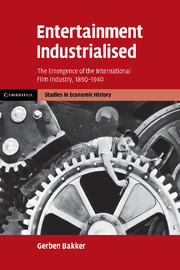Book contents
- Frontmatter
- Contents
- List of figures
- List of tables
- Acknowledgements
- Prologue
- 1 Introduction
- Part I The rise of entertainment
- 2 The emergence of national entertainment markets
- 3 The increase in demand for entertainment
- 4 The structure of household entertainment expenditure
- Part II The rise of the international film industry
- Part III Entertainment Industrialised
- Bibliography
- Index
3 - The increase in demand for entertainment
Published online by Cambridge University Press: 08 July 2009
- Frontmatter
- Contents
- List of figures
- List of tables
- Acknowledgements
- Prologue
- 1 Introduction
- Part I The rise of entertainment
- 2 The emergence of national entertainment markets
- 3 The increase in demand for entertainment
- 4 The structure of household entertainment expenditure
- Part II The rise of the international film industry
- Part III Entertainment Industrialised
- Bibliography
- Index
Summary
The underlying forces that shaped the demand for entertainment came in three pairs. The first pair, the growth of disposable income and leisure time, increased the demand for entertainment. The second pair, urbanisation and new transport networks, enabled the entertainment industry to turn more and more of this demand into consumption. The last pair, the birth rate and immigration, increased the population below thirty years of age, the sector that consumed most entertainment.
These factors did not just affect entertainment but also recreation demand in general. This chapter therefore examines the latter longitudinally along with the consumption of spectator entertainment itself. The next chapter will investigate these at the cross-section for several benchmark years.
The industrialisation hypothesis suggested that a sharp rise in demand – especially at lower incomes – caused bottlenecks in entertainment production. This resulted in large rewards for entrepreneurs that could provide more entertainment at lower prices or at a higher quality. The former will be investigated through a demand curve constructed in the next chapter, the latter will be discussed in Part II, on the quality race between film companies during the 1910s.
Underlying factors shaping demand
The increase in leisure time
Time and money both affected entertainment consumption. People had to decide how many hours to spend on labour versus leisure, what to do in the resulting free time, and how much to spend on it.
- Type
- Chapter
- Information
- Entertainment IndustrialisedThe Emergence of the International Film Industry, 1890–1940, pp. 72 - 109Publisher: Cambridge University PressPrint publication year: 2008



